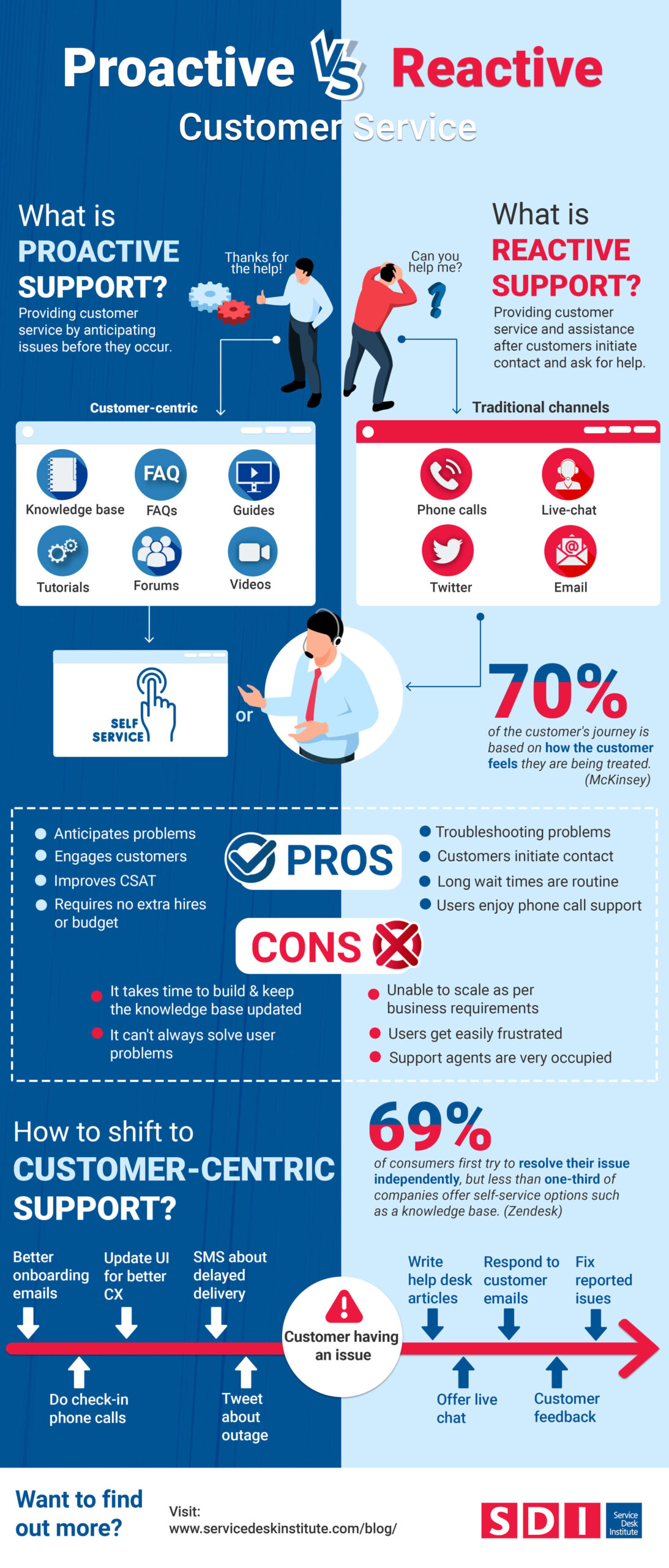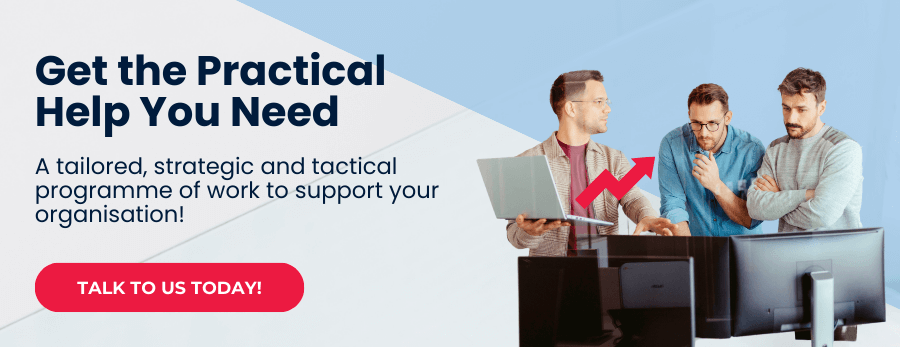 Back to Resources
Back to Resources
Proactive customer service has been at the top of the list of customer service trends for many years. By being proactive in engaging with customers, businesses can improve satisfaction, loyalty, efficiency, and brand image.
Although the benefits are obvious, some customer service teams have not fully adopted this approach because of challenges and barriers.
In this article, we’ll answer what is proactive customer service and why it matters. We’ll also look into some expected benefits and challenges.
So, let’s dive in!
Why Reactive Customer Service Isn’t Good Enough?
Many organisations still operate strongly reactively. This means that they only help customers after they have issues and ask for assistance.
Historically, the majority of Service Desks have seen themselves as a reactive, break-fix function.
There’s nothing wrong with waiting for customers to make the first move and ask for help. But is this reactive approach sustainable, and does it really provide effective support services and a great customer experience?
Unfortunately, fighting fires in support services is very common, and reactive support can be ineffective. Not addressing service issues proactively can often lead to low self-service containment and unhappy end-users. It also makes it easy for end-users to disengage.
“A proactive service desk anticipates problems and crafts solutions before issues arise, enhancing efficiency and customer satisfaction. In contrast, a reactive service desk waits for problems to occur, addressing them only when they become urgent, often leading to downtime and frustration.”
~ Auxis
That’s where proactive customer service comes in. Offering proactive support services first seems to be more effective. Even if you address this firefighting challenge, the likelihood is that end users will still hold onto that poor customer experience.
They could also hold onto their feelings about your products or services. And once the damage is done, getting the customer’s trust back is challenging.
So, how do you have more customised interactions and deliver a great end-user experience?
What is proactive customer service?
Proactive customer service involves anticipating customer needs and addressing issues before they arise. This strategy focuses on creating a seamless and positive customer experience. This customer-centric approach is also time-saving and efficient for both end users and support agents.
📊 “According to Zendesk, 90% of businesses have made customer experience (CX) their primary focus. This indicates a focus on customer satisfaction and proactive support measures.”
Taking a more proactive approach can help increase customer engagement at every funnel stage, increase revenue and decrease churn.

Proactive customer service offers numerous benefits that contribute to a better customer experience.
⚡ Some of these benefits include:
✅ Helps you anticipate customer problems.
✅ Increases customer engagement.
✅ Reduces the number of issues that get through to agents.
✅ Encourages use of real-time channels (live chat, chatbots, video chats).
✅ Lowers operational costs by reducing the volume of incoming support requests.
✅ Easier to scale as your business grows.
✅ Builds high customer loyalty.
✅ Higher customer satisfaction and improved CSAT.
✅ New customer acquisition and increased sales.
✅ Improves the perception of the brand.
It’s also important to remember that proactive customer service comes with its own set of challenges. To implement this strategy effectively, it’s crucial to address these challenges directly. Think about careful planning, investment in the right technologies, and a commitment to continuous improvement.
By tackling these challenges, businesses can fully leverage proactive customer service to enhance customer satisfaction and loyalty.
💡 Here are some of the main challenges:
⭕ Implementing proactive customer service is expensive and demands significant time and effort.
⭕ Proactive service relies on accurate and comprehensive data, which can be complex to integrate and raises privacy concerns.
⭕ Possible compatibility issues with existing systems.
⭕ Finding a balance between being helpful without being intrusive.
⭕ Shifting to a proactive approach requires a cultural change and continuous training and support.
⭕ Training staff and getting them to embrace proactive practices fully can be difficult.
⭕ Defining and measuring the right KPIs for proactive customer service can be complex. Determining the direct impact can also be challenging.
Example
One of the ways organisations can overcome these challenges is by working with outsourced service desk providers who can bring in top-quality, specialised talent at a much lower cost. For example, a prestigious Boston, MA-based university worked with nearshore IT services pioneer Auxis to achieve a proactive help desk.
Auxis helped them achieve this by providing standardised 24/7 services, global service coverage, and consistently achieving Customer Satisfaction Scores of 85%, among other positive outcomes.
The power of proactive customer service
Understanding your customer’s journey is crucial for businesses looking to provide exceptional customer experiences. To enjoy the benefits of proactive customer service mentioned above, you must know how to prepare your organisation and team for a human-first approach.
So, how can you switch your mindset from dealing with current issues to solving them in the future?
Let’s look at the ways to implement a proactive customer support strategy:
#1 Understand your customer’s journey
By taking the time to map out each step of the customer’s journey, you can gain valuable insight into their needs, preferences, and pain points. This information can help you identify areas where you can provide proactive support to enhance the overall customer experience.
Creating a customer journey map doesn’t have to be complicated. Start by identifying the key touchpoints in the customer’s journey, from the initial contact to post-purchase follow-up. Consider what the customer is thinking, feeling, and doing at each stage, as well as any potential roadblocks or obstacles they may encounter along the way.
Once you understand the customer’s journey, you can begin to plan proactive customer service based on their requirements. This may involve implementing new customer service processes, offering personalised recommendations, or providing timely assistance when issues arise.
By predicting and addressing customer needs before they arise, you can build stronger relationships with your customers and create a more seamless and enjoyable experience for them.
#2 Ask customers for feedback regularly
Monitoring feedback is crucial for service improvement. Implement feedback loops to gather customer responses to proactive measures and adjust accordingly. Conducting regular customer surveys is one way to do so.
💡 Some of the options are:
1️⃣ Event Surveys—These surveys involve asking for feedback after closing incidents or service requests. Capturing feedback in real-time provides specific insights into the customer’s experience and satisfaction with the resolution process.
2️⃣ Periodic Surveys – Users regularly receive them, for example, every six months or once a year. These surveys can help you identify trends and patterns in customer feedback to drive strategic long-term decisions.
3️⃣ Pulse Surveys – A short and regular set of questions to provide helpful information on end-user satisfaction. This continuous feedback loop is crucial for maintaining high service quality and customer engagement.
4️⃣ Voice Call Survey – asking users to complete a survey after calling the service desk
5️⃣ Random Sampling Surveys – This involves calling customers randomly after an incident or service request is closed. This approach ensures a diverse range of feedback, providing a broader perspective on service performance.
#3 Knowledge sharing is important
Customers like to find answers on their own, so it’s essential to have a knowledge base and self-service options. Harvard Business Review found that 69% of consumers first try to resolve their issues independently before asking for assistance. However, not many organisations are taking advantage of this trend.
Zendesk research shows that less than one-third of companies actually offer self-service options such as a knowledge base.
Consider creating a knowledge base for customers and the customer support teams. This will help you provide effective and faster solutions to all customer queries and improve the overall experience.
#4 Leverage new technology solutions
Having the right tools and technology solutions in place is essential to improving customer experience. It can also help with tackling an increasing number of customer requests. Start with scalable solutions that can grow with your business. Utilise advanced analytics and machine learning tools to predict customer needs and potential issues accurately.
💡 Think about leveraging solutions like:
✅ Live video and video chats
✅ Co-browsing
✅ Auto ticket creation systems
✅ AI-driven bots
✅ Virtual Agents
✅ Automation and remediation platforms
📈 “According to Tidio, 67% of organisations use chatbots for basic information gathering and obtaining customer feedback. This means that automating these routine tasks allows 77% of agents to focus on more complex work.”
AI-powered bots are a great solution for real-time conversations and are available 24/7. They can also help you understand your customers’ habits and analyse the gathered customer data.
You should also consider implementing system health checks and predictive maintenance to prevent downtime. AI can analyse support tickets and identify recurring issues to address proactively. These innovations enhance operational efficiency and improve overall customer satisfaction.
“Having the right modern tools, such as chat, bots, GenAI, and strong documentation allow us to enable self-service for users, which improves customer experience and drives our service desk to be more proactive,” said Jose Alvarez, Managing Director of Infrastructure Technology at Auxis, a leading nearshore help desk outsourcing provider.”
Here’s a great example of how Alvarez’s team transformed users’ experience for their clients. They implemented several automation initiatives for the outsourced service desk supporting 4,000+ stores for a major food service brand operator. This included automated ticket creation, automated ticket resolution, and chatbots and virtual agents that help human service desk agents handle multiple interactions.
🎯 The result: Auxis’ IT support team achieved a 96% SLA from its customer, with an Average Handle Time (AHT) of 20 minutes.
#5 Empower employees with tools & training
Another way to meet customer expectations is to invest in your agents. Clearly communicate the benefits of proactive service to your agents. Provide continuous training and resources to help agents understand and adopt proactive practices. Encourage a customer-centric mindset throughout the organisation, rewarding proactive behaviours and successes.
By putting more time into your agents and offering tools and training, you ensure they can provide better service. As a result, you will also have higher employee and end-user satisfaction ratings.
Getting The Most with a Proactive Approach
Is proactive customer service the future of the support world? Is that the only strategy you need?
Of course, you can’t read customers’ minds and anticipate every single need they have. So, the best strategy is the one that combines the two: proactive and reactive customer engagement.
Remember, by understanding your customer’s needs and proactively addressing them, you can enhance their overall experience. Balancing proactive customer service with responsive support can lead to more positive interactions and stronger customer relationships.
Do you need help with improving your IT services?
Our tailored service improvement plans boost efficiency and effectiveness. From Software Asset Management (SAM), process automation, and peer-to-peer benchmarking to data analysis. These strategies can help you create an effective proactive customer support system that anticipates and resolves issues quickly. Discover more on our Service Improvement Plans page.

















